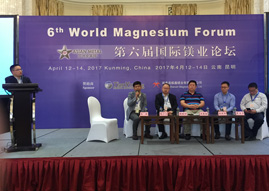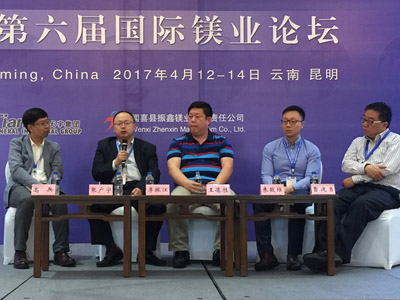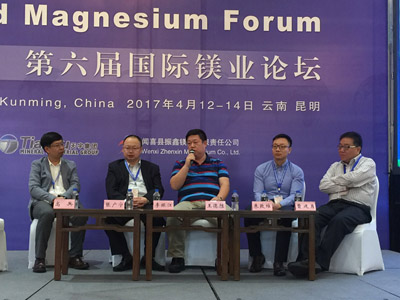Magnesium giants discuss the market at 6th World Magnesium Forum
----Chinese magnesium industry enters new era
- Host:
Gao Bing, Vice General Manager from Nanjing Welbow Special Metals Co., Ltd.
Guests:
Zhang Guangning, General Manager of Shanxi Crdit Magnesium Co., Ltd.
Li Zhenjiang, General Manager of Hebi Jianglang Metal Co., Ltd.
Cao Jianyong, General Manager of Chongqing Shengmei Magnesium Co., Ltd.
Zhu Zhiwei, Foreign Trade Director of Yulin Tianlong Magnesium Co., Ltd.
Wang Desheng, General Manager of Hongkong Yuxin Development Co., Ltd.
- Mr. Gao: Since we met in Xiamen in 2016, one has passed, and today we meet again in the City of Kunming. At first, let us extend our sincere gratitude to Asian Metal for providing us such an excellent view-exchanging platform, and also to guests and participants present in the discussion today.
- We are old friends, and have come along to have discussions on the magnesium industry. Please feel free to ask questions, no matter on which topics, no matter to guests or to me. Enlightening questions are particularly welcome since they help expand our visions and thinking. I myself always benefit a lot from each meeting with you, magnesium magnates. At first, let me make an introduction on our guests today. Mr. Zhang Guangning, general manager of Shanxi Yanbixin Magnesium Co. Ltd., and he always gives us many suggestions when we met. Mr. Li Zhenjiang, general manager of Hebi Jianglang Metals Co., Ltd., a leading light in the magnesium industry. Mr. Wang Desheng, general manager of Hong Kong Yuxin Development Co., Ltd. His businesses cover countries around the world, though he himself lives in the U.S. and his suppliers are based in China. And today Mr. Wang will talk about how to make a living in the magnesium market. Mr. Zhu Zhiwei, foreign trade director of Yulin Tianlong Magnesium Co., Ltd., whom I have been acquainted with for many years; His company has been doing well, and we hope to learn about its latest developments. And the last one is Mr. Cao Jianyong, general manager of Chongqing Shengmei Magnesium. What’s noteworthy is that Mr. Cao is also a poet, and we hope that our next magnesium forum can start with Mr. Cao’s poems.
- Now let’s begin our discussion. The first question goes to Mr. Zhang. Mr. Zhang seems not very satisfied about the magnesium industry, saying that it has been disorderly to some extent in the recent years. Would you please explain about the word “disorderly” in the magnesium industry? Let’s welcome Mr. Zhang.

- Mr. Zhang: Thanks. This is just my personal views, and I sincerely welcome discussions with you if you disagree or I say something you think wrong. Long involved in the magnesium industry since 1996, I have witnessed the industry developing from its neonatal phase into today’s dimensions. Before 2016 was the so-called Tongxiang Era, during which the province of Shanxi was the most important magnesium production base in China and its market was the best across the country, in terms of market standardization, industrial disciplines, concentration and maturity. But in 2016, all of us experienced extreme price fluctuations, especially after 20 December, 2016, prices plunged by RMB3,500/t within only 20 days. Though during April 2016 when the Xiamen Magnesium Forum was held, price upticks in the magnesium market were also dramatic and last for a long time. But it was incomparable with price fluctuations in that December. After December 21, prices plunged sharply from RMB16,500-16,700/t D/P ex works to RMB13,000/t D/P ex works, and some even fell to RMB12,700/t D/P ex works, a result from large volumes of stocks held in hand. Indeed, the whole magnesium industry was badly affected, especially at a time when the development of an industry depended upon its application in the downstream industries. Such vehement price fluctuations imposed great damage upon the whole industry, and who are the winners? I believe they were foreign purchasers. This is my first point of view.
- Secondly, I want to ask for what purpose we consign ourselves to so many and such arduous work, busy all through the year, while at the year-end everyone feels so little has been harvested. I believe that an industry is not mature and can not move on smoothly until when everyone’s interests and stake have been linked with it.
- Thirdly, I want to emphasize that development of the magnesium industry essentially depends on its applications in the downstream industries. But the current situation is that the market fluctuates vehemently and has great difficulties in expanding its downstream applications. At present, automobile and IT are the two major fields where magnesium is most widely used. What’s often seen is that when we just signed orders with our downstream customers, prices for our raw materials soared at the same time. Our customers kept complaining; on the other hand, we fail to further expand our shares in the downstream industries. As a result, the magnesium industry is greatly stymied in its development. Though profits are always the goal a commercial enterprise pursues, I still hope that we can focus on application in and demand from the downstream industries, which is the direction and engine for development of the magnesium industry. Prices are finally dictated by market and demand, without which all of us are losers. In summary, what we need to do is to focus upon application and demand, and work together to protect them; only by doing so, the magnesium industry can enjoy a bright future. That’s my point of views and thanks a lot!
- Mr. Gao: Thanks. As Mr. Zhang. emphasizes, application is the most important direction for the magnesium industry. My question is that during the past years what has been the growth point for magnesium products in the global market? Or whether there have been major breakthroughs in the application of magnesium metal?

- Mr. Zhang: Everyone engaged in the magnesium industry should be confident about the prospects of magnesium applications. Besides industries I have mentioned, automobile and IT, magnesium metal has also been used in other industries. Compared with other metals or materials such as aluminum or carbon fiber, magnesium has unbeatable advantages. The automobile industry now prioritizes or gravitates toward development directions of new energy and light-weight automobiles, which I think is a great chance for the magnesium industry. For example, one of our customers plans to increase their consumption of magnesium alloy to 100,000t by 2020. I am sure such a plan is based upon strong downstream demand for their products, without which they dare not to formulate such a 100,000t development plan. So I believe that the magnesium industry has great potential in expanding its downstream applications. But the crucial point is that the magnesium alloy industry needs more enterprises such as Welbow Special Metals to take the lead of the industry, and why the industry fluctuates so greatly now is because it lacks more such companies to consolidate itself. But as a leading company, its size, management, market shares and acceptance, as well as its resources, have to have reached a certain high level before it can lead the industry to improve its self-discipline. And improved self-discipline is a prop for the magnesium industry. This is what I want to share with you. Thanks.
- Mr. Gao: Thanks very much. And I want to add that the customer Mr. Zhang just mentioned is the largest producers of magnesium alloy die castings in the world. Currently, its annual consumption of magnesium alloy is about 50,000t, which is expected to double in the following three or four years to 200,000t by 2020, as mentioned by Mr. Zhang. So from this case we can see that how quickly demand for magnesium is growing. Thanks again.
- Next, I would like to invite Mr. Li Zhenjiang from Hebi Jianglang Metals Co., Ltd. to share with us his point of views.
- Mr. Li: Let me first thanks Asian Metal for providing such a platform for us to exchange views and ideas.
- I believe that growth points in the magnesium industry will come from the Chinese market. Chinese steel mills have been affected by environmental inspections and their consumption of pure steel products are on the rise. Under such a background, it is likely that there will be tens of thousands more of magnesium powder consumed in the following three to five years.
- While regarding the overseas market, I feel it is dwindling, which may be related to too vehement price fluctuations for magnesium. In order to avoid risks, a few companies in Hebi city have worked together with government to set up a joint venture, a magnesium syndicate, to make uniform purchases in order to drive our production costs down. Government provides the platform and we enterprises provide financial inputs. Such a cooperation model can provide some necessary security to us. The initial investment is RMB300 million, and in the future it will rise to RMB1 billion. By doing this, downstream application for magnesium ingot will be better protected. In addition, I want to mention a share bike brand Mobike, I think another growth point for magnesium application, in the civil industries. Thanks.
- Mr. Gao: Thanks. Similar to many other industries, when the international market is not better enough, we can shift to our domestic market where demand is growing. So we need to work hard to cultivate domestic demand. This is also a new direction for development. Price fluctuations in a certain industry usually impose much trouble upon its downstream industries, including processing industry as its production costs and profit margins are usually fixed, lacking effective ways to offset losses caused by rising prices. And a new method or measure may help push the whole industry to move forward if it succeeds.
- Now let’s welcome Mr. Wang Desheng from Hong Kong Yuxin Development CO., Ltd. to share with us his ideas.
- Mr. Wang Desheng: Thanks Asian Metal for inviting me to take part in this meeting. >From the first forum to the current sixth forum, I missed only once as time did not permit. I have witnessed the growth of Asian Metal. Now many insiders take it as the weather vane of the magnesium market, and we hope that it will be more successful in the future.
- I would like to take this opportunity to express some personal ideas. Since 1993 I have been working in the magnesium industry, and sometimes I like to joke that I myself is a survivor from ups and downs in the magnesium industry. The current market can be depicted as unpredictable, quite different from what it used to be. Back to the years from 1993 to 2013, there were also ups and downs in prices, but as a trader, we did not suffer losses in 90% of our sales as we could largely predict price movement trends. In 2018 when prices soared dramatically, we maintained profit margins of over RMB7,000/t from selling prices of over RMB30,000/t. Of course, as a special phenomenon, it could be not replicated again. At that time outputs of magnesium plants were usually low; though prices kept rising, it was difficult to increase outputs. In addition, the 2008 Olympic Games were held in Beijing, and government placed an extremely high hand on environmental protection.
- However, since 2013 to now, only 70%, at most, of my predictions are right, while sometimes I make so wrong predictions that I suffer very serious losses. In the first half of 2016, I signed some contracts but lost a lot. One of examples I would like to share with you is our orders from Webow Special Metals. Say we received its order in February; but according to its operation schedule, I needed to produce and deliver the products to it in April. So there would be a two-month gap between order receiving and production. If I bought the material in late February, it would take up a large amount of capital and also led to increased financial costs. So we decided not to purchase the material in late February. But prices kept rising during the following two months. I originally anticipated that price upticks may be limited to within RMB500/t; but the actual situation was not so. So our previous experiences did not match what was happening then. Nevertheless, I did not get depressed but quickly adjusted our business strategy in the latter half of last year, in order to meet up with the latest market conditions.
- Here I would like to share with you four words in order to quickly and more accurately respond to market changes. The first is diligent. As the market fluctuates quickly, we should strengthen our communication with factories, traders and customers. If we used to contact them once a week, now we have to contract them more frequently, since prices may decrease at 9 and then go up at 10. If we are not diligent enough, we may miss many chances. The second word is quick. With information already received in hand, we have to make our judgment quickly. I usually work into 2 o’clock in the early morning in the U.S., or 5 o’clock in Beijing, as the time gap between Los Angeles and Beijing is 15 hours. Once, as I had not finished my job at 2 a.m., I received a purchasing order from one of my customers and then made the decision at 3a.m. In the daytime I got to know that prices for magnesium ingot rose by RMB200/t, which meant that I had to pay RMB100,000 more if I did not decide to buy immediately after receiving the order. The third word is greed-averse. I feel that in many cases the reason why many traders suffer wrong predictions and losses is greed. When we receive an order, we intend to keep watching the market, hoping that prices can move down further, even if they have already dipped, and thus miss the chance. And the fourth word is honest. For traders, credit is the most important. 2017 is the 24th year for me to be involved in this industry, and I am proud of myself for never reneging upon any contracts over the 24 years. This is why my company survives now.
- I also want to give some suggestions to magnesium ingot producers. I feel that today’s magnesium ingot producers should be different from magnesium plants in Shanxi before. I recommend that magnesium enterprises in Fugu county enhance their exports-oriented awareness, which can help improve their management and improve products quality. Take Tianlong Magnesium as an example. Its products are used in Boeing planes, and the company implements a very strict management procedure on its supply chain. Though requirement on magnesium contents in its products are low, its requirements on package and other aspects are quite strict. No ball-point pens are allowed to be brought into the production workshop because its cartridges will bring about deadly damage upon the product quality, if they fall into the refining pots. In addition, no incandescent light bulbs are allowed in all of its refinery workshops. Once producers can guarantee that every link in their management chain is prefect, it’s no problem that products are of premium quality and can be sold at a satisfactory price.
- I also have some recommendation for traders. I began with my business in the Japanese market and still do so today. But I find that Chinese suppliers’ quotations to Japanese customers vary greatly. Generally speaking, quotations for magnesium ingot from Chinese suppliers hold at around USD2,200/t, but every time there are always Chinese suppliers who quote at quite lower prices than that. Despite this, some of them may still fail to win the contracts. Why? Because Japanese customers will parcel out their orders to three Chinese suppliers in order to reduce their risks, and the three suppliers then decide how much they would like to sell according to purchasing prices from those Japanese buyers. But low prices do not always prevail every time. Sentiment behind this phenomenon is that Chinese traders are eager to win the orders first, before deciding what to do next. But they may fail to win the orders at last. So i recommend that Chinese traders make reasonable evaluations before making quotations so that they can make profits.
- Finally, I would like to express an expectation for both producers and traders. I have a feeling, since last year, that traders and producers seem to have fallen into two different camps of interests. Today they joint hands in selling nothing, and tomorrow they may work together refusing not to buy. But all the fluctuations and changes in the market have shown that the market runs not at the mercy of individual players. All the players should work together rather than antagonize each other. Thanks.
- Mr. Gao: As a 24-year-career magnesium senior, I am sure that Mr. Wang has spent a lot of time in reviewing the industry and his four words absolutely serve as a useful directive for us. As Yunhai Special Metals staff, I want to respond to Mr. Wang as he just mentioned that Yunhai Special Metals requires a long supply cycle. At present, we have 12 magnesium-alloy production lines running at full capacity, producing over 13,000tpm. We did not shut down even during the Spring Festival. In the short term, such a trend will not stop, and we will continue to expand our production capacity. In the second half of 2017, we will have another four production lines built in our Chaohu and Wutai factories, and our daily output of magnesium alloy will increase by 500t then. I hope that this may help solve the issue Mr. Zhang mentioned just now.
- Next, let’s welcome Mr. Zhu Zhiwei from Yulin Tianlong Magnesium to brief the latest development of his company.
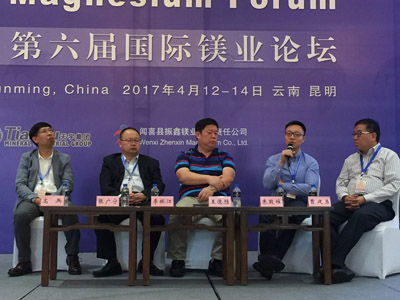
- Mr. Zhu: Our company is among companies which were engaged at an earlier time in the magnesium industry in Gufu county. For two years we also dabbled in the magnesium alloy field, but compared with Mr. Wang’s company, we seem to be only a lay business. At that time, we were not well prepared for the magnesium alloy industry, neither well aware of its downstream industries. Later, as our production technique on magnesium ingot production improved and quality picked up; meanwhile, as we found that it was not economically feasible to produce alloys with magnesium ingots produced by ourselves, and also owing to unsteady production conditions, we suspended alloy production, just focusing upon our main business, magnesium ingot production. Now we hope to increase our ingot outputs as we find that, though our outputs used to be of large quantity, we have lagged behind now. So we decide to introduce some new programs in the second half of 2018 or in 2019.
- I am deeply moved by Mr. Wang’s speech. Also a senior member of the magnesium industry, I believe that credit is very important. We should not renege upon our commitments, no matter what happens in the market. I am also proud of myself for not doing such things.
- Mr. Gao: Thanks. I agree with you and Mr. Wang. Credit is crucial in deciding whether a company can exist for long.
- Next, let’s welcome Mr. Cao Jianyong from Chongqing Sun Magnesium Co., Ltd. to share his ideas. Could you tell something about your latest development?
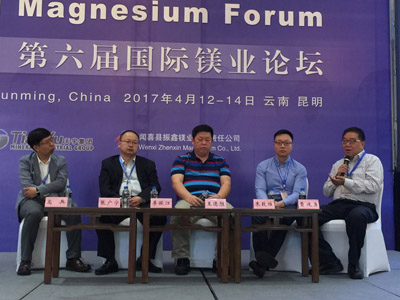
- Mr. Cao: Thanks a lot. The consensus is that automobile will be the largest application market for the magnesium industry. Previously we said that the goal of 20kg of magnesium being used in an automobile will be achieved by 2015, but now it seems that 2020 or 2025 may be a more feasible goal. I myself believe that 2025 is possible. But there are two question to be answered: the first one is what output of the whole magnesium industry should maintain in order to meet up with such a goal? The second one is how many magnesium products are needed for 10 million automobiles if the goal of 20kg being used in one automobile can be realized? That is 10 accessories for each automobile, if 2kg for one. Who will be the investors and who will be the producers? Rome is not built within one day. Instead, a long time is needed for solving issues related to techniques, management, evaluation, quality administration as well as design. The case now we can refer to is Wanfeng Auto Wheels which purchased MLTH Holdings Co., Ltd. I believe that a long way is still ahead of us, though it indeed entails a lot of opportunities.
- I have a question for Mr. Gao. Your vertical-pot smelting technique, with its advantages in production costs controlling, will be the biggest challenger against electrolytic technique. Could you make a comparison between these two techniques in terms of production costs.
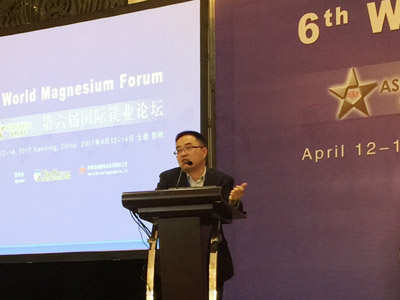
- Mr. Gao: This year, our crude magnesium output is estimated to amount to 70,000-80,000t, while last year this figure was 65,000t. We have two factories to produce it, one in Chaohu (Anhui province) with a monthly output of about 3,000t, and the other in Wutai (Shanxi province) with a monthly output of 3,000-4,000t, both of which are still on the rise. Our magnesium ingots are different from yours as they are mostly used to produce liquefied magnesium alloy, not sold in the market. Sometimes we even need to purchase the material from outside. Our first plan is to realize a production capacity of 100,000t crude magnesium, which is likely to happen in the second half of this year, or the end of next year as the latest. 2016 was the most difficult year, but also a good year for our company. We hope that in 2017 we can do better. From our financial reports you can see that our revenues for the most part come from raw magnesium and magnesium alloy. The annual financial goal for our factory in Wutai is RMB100 million, and its crude magnesium output is about 50,000t. We have planned to build a third crude magnesium factory, which will adopt Pidgeon smelting technique and will the most cost-effective in this field. Research on its locality is underway now. Of course, to save production costs, we need to consider every aspect including production technique, vertical pots, deslagging, efficacy, as well as burden design. Vertical pots are used in our Chaohu and Wutai factories. We have spent a huge amount of money in research and technique upgrading in these factories. About RMB750 million have been invested into the Wutai factory, of which 30% was used in eliminating old furnaces and developing new ones. But such expenses can be recouped in the future when the technique is mature. We also plan to build another new factory which is expected to be located to the south of Yangtze River since what we need to consider are issues like ores, energy, customers and technology.
- At present, all of us adopt the Pidgeon technique in our production. Whether you use horizontal or vertical pot is not crucial in controlling production costs. There are no such things we can say are the best, but only things that may be better. Even if market conditions are good enough, there are always companies which suffer losses; while in poor market conditions, there are companies which make money.
- As for electrolytic technique, I am not so well aware of it and can say too much about it. Our Pidgeon-related production costs are not fixed, but affected by factors such as ferrosilicon the raw material, energy or even transportation; while advantages of electrolytic technique is that its production costs remain stable since electricity charges and equipment conditions are relevantly stable. Of course, stability is important, but I think that reasonable costs are more important. To achieve large-scale application of magnesium, we have to have our production costs slashed. If magnesium prices are always today’s RMB40,000/t, it’s impossible to talk about its large-scale application since there are so many substitute products out in the market, such as aluminum, steel, carbon fiber and so on. But let’s envision what will happen if we can keep our production costs under RMB10,000/t? It is possible that 40kg or 100kg of magnesium can be used in one automobile, let alone 20kg. Of course, it is no easy job to keep production costs under RMB10,000/t. This is my thinking. Thanks.
- Mr. Gao: If our audience have any questions to our guests, please feel free to ask.
- Mr. Zhen Zisheng: I quite agree with Mr. Gao that only based upon reasonably controlled production costs can we talk about downstream application of magnesium. We know Yunhai Special Metals does well in using the Gidgeon technique, especially in vertical-pot technological innovation and research. I have a question to Mr. Gao about prices and production costs of magnesium. What is the reasonable price range for crude magnesium and magnesium alloy in the coming two or three years?
- Mr. Gao: There are two major factors affecting production costs, prices for raw materials, such as ferrosilicon and energy, and supply-demand relation. In the previous years, especially from 2008 to 2015, profit margins of magnesium enterprises were quite slim and there were some which even exited the market. But since 2015, prices have been on the rise, indicating that supply-demand relation is returning gradually to a relatively healthy level, no matter for magnesium ingot or magnesium alloy producers. Take us as an example. In late 2016, as we were busy receiving orders, we even raised alloy treatment charges of one of the orders. This was the first time in my career life. The market is returning to a balance between supply and demand from the difficult situation of large outputs and difficult transactions years ago. In the recent years supply at times even becomes tight. A re-balanced supply-demand relation is good for the whole industry. As for the question what is the reasonable price range in the future, it is difficult to digitalize it but I think it’s not as important as the supply-demand relation. I am sure that so long as supply-demand relation remains reasonable, the magnesium industry will move on healthily.
- Mr. Gao: Traditionally, we will discuss price trends at last; but today we won’t do that. An existing price is a reasonable price, and moreover, today’s prices are indeed more reasonable than in the previous time. Let’s remember that supply-demand relation rather than price is the most important.
- We have witnessed growth and progress happening in the magnesium industry, seeing its high-end applications such as in automobiles, planes and rockets, and also applications in our daily life, such as in share bike. Though there are still questions and difficulties ahead of us, we are still confident about a better tomorrow. Finally, I want to thank all of you again for taking part in today’s discussion, and hope to meet again next year.
